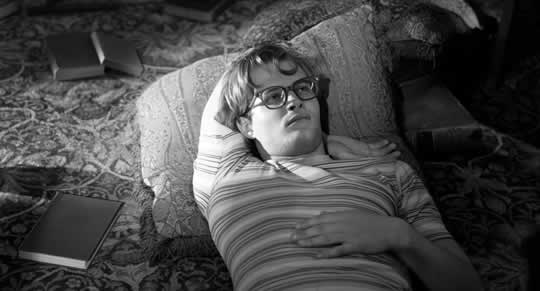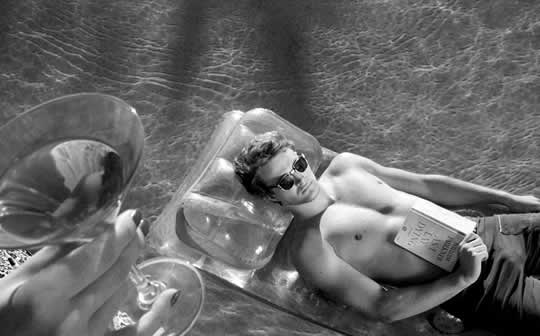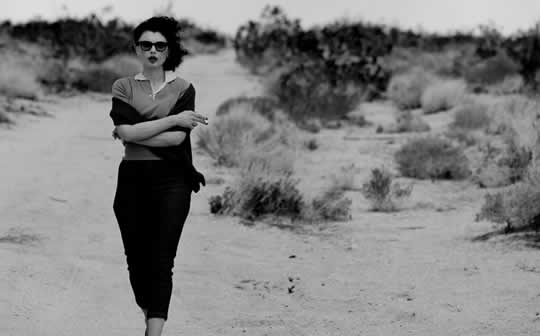 Debut feature by director Matthew Mishory is a highly stylized period piece centered on and around James Dean, pre-fame. Executed almost to the point of pedantry, Mishory’s film is set in 1951 Hollywood, taking occasional metaphorical exit into the desert landscape of the Joshua Tree national park, about halfway between L.A. and Palm Springs in southern California. Joshua Tree serves a dual purpose: as an unattainable state of peace for someone as restless as Dean, and at the same time harboring, exactly like Dean, some invisible force of nature just under the surface.
Debut feature by director Matthew Mishory is a highly stylized period piece centered on and around James Dean, pre-fame. Executed almost to the point of pedantry, Mishory’s film is set in 1951 Hollywood, taking occasional metaphorical exit into the desert landscape of the Joshua Tree national park, about halfway between L.A. and Palm Springs in southern California. Joshua Tree serves a dual purpose: as an unattainable state of peace for someone as restless as Dean, and at the same time harboring, exactly like Dean, some invisible force of nature just under the surface.
“Joshua Tree 1951: A Portrait of James Dean” is a philosophical work of a young auteur who aspires to put a different cinematic spin on the biopic formula with highly formalized staging, slightly surreal and absolutely gorgeous black & white imagery, and directing style of an intellectual who’s making a statement through the medium of film. Looking at “Joshua Tree” only as a sub-genre gay movie would be missing the point. So James Dean was gay, is that what’s it all about? Once you’re past the sexuality angle and start looking at everything this film brings forward, the image of a puppet-master reveals itself like the shadow forming in the photographs of David Hemmings in 1966 “Blow-Up” (Michelangelo Antonioni). “Joshua Tree” is a film about the filmmaker and his relationship with the medium of film. All available tools are used to make that point: every button on every period blouse is perfect, as it should be in a period piece; the film was shot (mostly) on 35mm black & white stock, as befits a period piece, and to assert, in case anyone missed it, the auteur nature of the work; and actors walk and talk like Jean-Pierre Leaud, declaiming his lines in the 1973 French cult classic “La Maman et la Putain” (“The Mother and The Whore”), by Jean Eustache. 
Matthew Mishory is re-connecting the audience to that cinematic tradition. Sure, he shows plenty of sex, most of it gay, just as the French and the Italians used to have sex as a backdrop for their cinema manifestos. “Joshua Tree” is the second, feature-length installment in director Mishory’s exercise in movie style and cinematic expressionism which aims to establish an auteur’s philosophy of the medium. Let’s not forget that action movies are also experimenting and utilizing bushels of CGI in an effort to revive the genre and keep it interesting for us. Mishory is doing the same thing with auteur film, employing formalistic scene staging and quotes from the French poet Arthur Rimbaud and author Antoine de Saint-Exupery’s “The Little Prince” to create that feel of the unique personal touch which made history back when the European auteurs ruled.
His courage lies not in making us see James Dean as a gay man (hardly news these days). I would wage that gay audiences may even find this film oddly unattractive, precisely because it is not a gay film, same as “Teorema” (‘Theorem’, 1968, by Pier Paolo Pasolini) is not a film where everyone screws everyone else, though they do that too. Pasolini exercised a very strict formula and applied it to every character development, to achieve a certain effect and present his social as well as personal ‘theorem’. Of course Pasolini’s work was influenced by his gay persona, but is that the reason why the history of film remembers him? More than anything, each cinema auteur presented the totality of his or her ideas eminently suited for the medium of film. Auteurs were interested in ‘stuff the films are made of,’ just as they were exploring their own political and philosophical views. Matthew Mishory should be credited with reconnecting us with that great tradition and making a cinematic statement as an American drawing from the European auteur tradition.
 What this film does accomplish may not be in the same league with predecessors it aspires to join. Mishory stops short of extended soliloquy and free-style musings, too concerned with moving things along. He may have been better served letting his poetic manifesto play out regardless of how wordy it may end up being. I sense a filmmaker on guard, not yet letting his ideas take him wherever they may. On the surface is the attention-grabbing gay movie icon, cushioning more subversive and interesting filmmaking ideas. These ideas however are never fully expressed. It feels like the film is constantly alternating between a remake of an old Hollywood movie, and subversive auteur manifesto. This reviewer is in favor of the latter, and time will tell if Matthew Mishory will follow his intellectual muse, or satisfy his obvious desire to remake the Hollywood movie reinventing the still iconic formula of the classic Hollywood films.
What this film does accomplish may not be in the same league with predecessors it aspires to join. Mishory stops short of extended soliloquy and free-style musings, too concerned with moving things along. He may have been better served letting his poetic manifesto play out regardless of how wordy it may end up being. I sense a filmmaker on guard, not yet letting his ideas take him wherever they may. On the surface is the attention-grabbing gay movie icon, cushioning more subversive and interesting filmmaking ideas. These ideas however are never fully expressed. It feels like the film is constantly alternating between a remake of an old Hollywood movie, and subversive auteur manifesto. This reviewer is in favor of the latter, and time will tell if Matthew Mishory will follow his intellectual muse, or satisfy his obvious desire to remake the Hollywood movie reinventing the still iconic formula of the classic Hollywood films.
The B&W photography by Michael Marius Pessah gorgeously captures the mood of this film. Production design by Samuel Perone, set decoration by Adam Nelson and costumes by Rod Saduski match director’s vision and the classic Hollywood look he wanted to recreate, stylized to remind us that this is a vintage piece after all. Actors faithfully follow director’s vision, including James Preston who plays Dean with restraint, keeping an opaque surface intact. However the scene that this film could use more of takes place in Dean and roommate’s apartment when the mother of Dean’s roommate pays a visit to the boys. The mother, with her perfect 50’s dress and coiffure, clearly out of place but not sure why, and the two roommates in the other room create an emotional vacuum emitting a silent scream as if Munch painted it. In spite of all the sex,  gay and otherwise, it is this vacuum that the ensemble cast is given to navigate and maintain its silent-scream nature.
gay and otherwise, it is this vacuum that the ensemble cast is given to navigate and maintain its silent-scream nature.
Matthew Mishory’s debut feature is written like an essay, filmed like a noir, and directed like auteur’s exposé on moviemaking. It makes us think about the expressive possibilities of filmmaking for our hybrid times. It is easy to forget that filmmakers with an artistic bent are precious. They deliberately make choices that could backfire as much as affirm their approach. Matthew Mishory followed his highly successful short film “Delphinium: A Childhood Portrait of Derek Jarman” (2009) with “Joshua Tree”, obviously mapping a road traveled by exceptional people he admires. Is there a trilogy in the making? Films about other film artists are exposés on film as an art form, and exploration of art in general. That, I believe, is what “Joshua Tree” is all about.
“Joshua Tree 1951: A Portrait of James Dean”, 2012; an Iconoclastic Features production; world premiere at the Seattle International Film Festival; international premiere at the Transylvania International Film Festival in Cluj, Romania. Written and directed by Matthew Mishory. Principal cast: James Preston, Dan Glenn, Dalilah Rain, Edward Singletary, Jr., Robert Gand. Produced by Edward Singletary, Jr., Randall Walk, Robert Zimmer, Jr. Web site: http://www.joshuatree1951.com/

